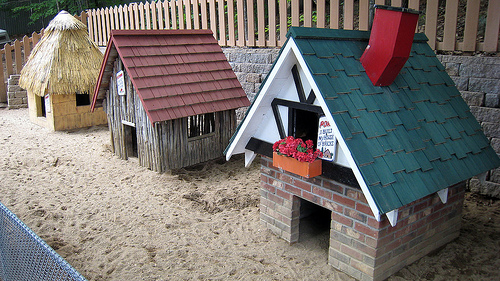You will begin this section on plot with a story instead of a definition.

Source: Where Did You Get Those Shoes?,
capn madd matt, Flickr
A man in a rooming house was in the habit of taking off his shoes at night and dropping them on the floor one at a time, with a pause for rumination in between. The lodger below had complained about this many times. One night, after dropping the first shoe, the man suddenly remembered the complaints and put the second shoe down gently. After twenty minutes had passed, an agonized wail came up from the room below. “For God’s sake, drop the other shoe.”
In one way or another, every plotted story makes us wait for the other shoe to drop. A plot is a series of fictional events that builds anticipation. Freytag’s pyramid is a chart of the escalating actions that make up the average plot. The line rises to a point as tension builds and slopes downward as the tension subsides.

Source: Freytags_Pyramid, Wikimedia
The typical plot is divided into five main elements. Those elements are exposition, rising action, climax or turning point, falling action, and resolution or denouement. We’ll illustrate each element with a familiar fairy tale, "The Three Little Pigs."

Source: 6765 three little pigs’ houses, kbaird, Flickr
- Exposition is the beginning of the story or the situation before the action starts. The author creates the conditions existing at the beginning of the story and describes the setting. The author establishes the main characters with their positions, circumstances, and relationships to one another, and introduces the exciting force or initial conflict. Sometimes called the narrative hook, this initial conflict will continue throughout the story.
A feeble old sow no longer able to care for her three ovine offspring sends them out to make their places in the world. A big, bad, underfed wolf is lurking in the neighborhood.
- Rising Action is the series of events, conflicts, and crises in the story that leads up to the climax, providing progressive intensity that complicates the conflict.
The first little pig hastily throws together a house of straw, and the wolf blows it down. The pig retreats to his brother’s house of sticks, which also proves to be vulnerable to the wolf’s breath on his next powerful exhalation. The homeless brothers make a speedy exit to the house of the third brother, who has painstakingly constructed his home from bricks. The brick fortress resists crumbling despite the best huffing and puffing of the sharp-toothed adversary. The wolf tries to lure the pigs outside, but to no avail.
- Climax is the turning point of the story. A crucial event takes place from this point forward, and the plot moves toward its inevitable end.
The wolf crawls down the chimney where the pigs have a boiling pot of water waiting.
- Falling Action is all of the action after the climax. The main character may encounter more conflicts in this part of the story, but the end is inevitable.
In the sanitized Disney version, the wolf hops out of the pot and runs away clutching his scalded behind. In a more violent version, the pigs wait patiently for bowls of wolf stew.
- Resolution or denouement is the tying-up of the loose ends and all the threads in the story. In this story's conclusion (below), the main characters emerge triumphant.
In this fairy tale ending, the entrepreneurial pigs start a new business. The Piggly Wiggly meat market eventually becomes a grocery chain.

Source: Mr. Ed, HW Photography, Flickr
Now let’s look at the bones of a true story and the facts that might be included, point-by-point, fact-by-fact, if you used this incident to plan and write a story. Here’s what happens:
A family leaves on vacation without locking their house, and the horse decides to move in for the weekend. The horse enters the house—and eats much of it—while they are away. Upon their return, the police get involved, and tears are shed (though not by the horse).
Now, knowing this information about this story, imagine that it follows the events listed below. For each phrase, determine where it belongs on Freytag’s pyramid. Is it exposition, rising action, climax, falling action, or resolution? To indicate your answer, drag and drop the number of each item below into the correct column.
